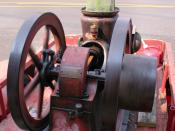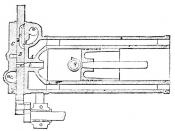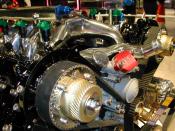- -
INTERNAL-COMBUSTION ENGINE
INTRODUCTION
Internal Combustion Engine, a heat engine in which the fuel is burned ( that is, united with oxygen ) within the confining space of the engine itself. This burning process releases large amounts of energy, which are transformed into work through the mechanism of the engine. This type of engine different from the steam engine, which process with an external combustion engine that fuel burned apart from the engine. The principal types of internal combustion engine are : reciprocating engine such as Otto-engine, and Diesel engines ; and rotary engines, such as the Wankel engine and the Gas-turbine engine.
In general, the internal combustion engine has become the means of propulsion in the transportation field, with the exception of large ships requiring over 4,000 shaft horsepower ( hp).
In stationary applications, size of unit and local factor often determine the choice between the use of steam and diesel engine.
Diesel power plants have a distinct economic advantage over steam engine when size of the plant is under about 1,000 hp. However there are many diesel engine plants much large than this. Internal combustion engines are particularly appropriate for seasonal industries, because of the small standby losses with these engines during the shutdown period.
History
The first experimental internal combustion engine was made by a Dutch astronomer, Christian Huygens, who, in 1680, applied a principle advanced by Jean de Hautefeuille in 1678 for drawing water. This principle was based on the fact that the explosion of a small amount of gunpowder in a closed chamber provided with escape valves would create a vacuum when the gases of combustion cooled. Huygens, using a cylinder containing a piston, was able to move it in this manner by the external atmospheric pressure.
The first commercially practical internal combustion engine...


